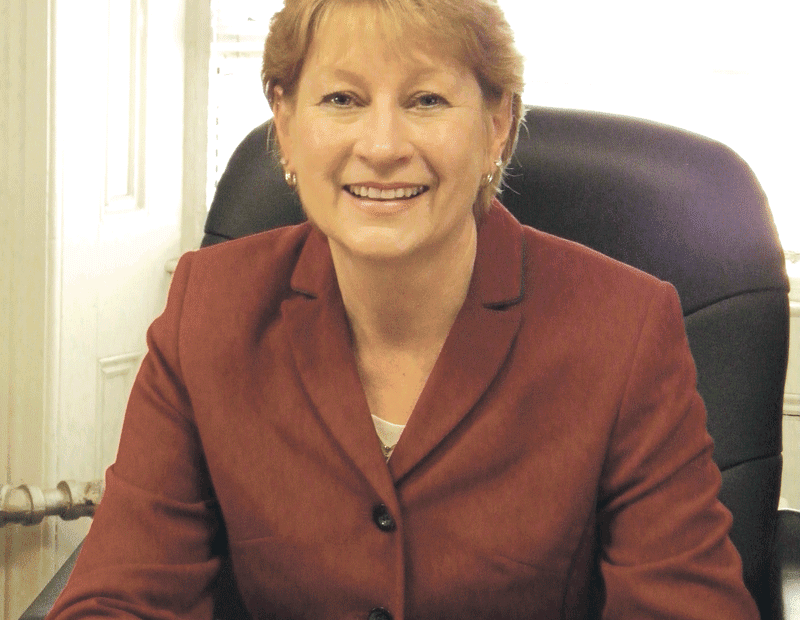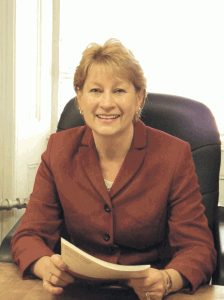
Sun-day School
Area Colleges Report Heated Interest in Summer Classes

Debbie Bellucci says a number of factors have led to a surge in summer enrollment, including a still-uncertain economy.
Summer used to be a time when college students took a break from classes and earned a little cash. But the downturn in the economy has changed that dynamic, especially at state schools where tuition is comparatively low.
Many students are trying to fast-track their education, while others who attend private schools are signing up for transferable summer courses at community colleges where tuition is inexpensive. The faltering economy has also led many adults back to school year-round to maintain or boost their marketability. They are often juggling myriad responsibilities, so the increasing demand for online courses, which are convenient and flexible, is changing the face of higher education.
The trend has also given birth to a variety of degree-completion options, as well as what are called hybrid classes, which combine online and face-to-face meetings, as the requirements for all courses can’t be completed online.
Bill McClure, executive director of the Continuing Education Department at UMass Amherst, said the university has seen an increase in demand for courses year-round. “It is generally accepted that, when the economy is down, the demand for education goes up,” he said.
Summer is no exception, and UMass students are taking summer classes in both undergraduate and graduate programs. “Last summer, online courses across the board were up by 30% overall,” he said. “However, face-to-face classes did see a decrease.”
Kimberly Tobin, dean of graduate and continuing education at Westfield State University, has also seen a pronounced demand for summer classes that began in 2008. “From 2008 to 2010, we had a 77% increase in the number of students taking summer courses online,” she said. “That’s huge for us. In addition, many faculty members have moved to hybrid courses, where they use the Web shell to post assignments, readings, supplemental materials, or PowerPoint presentations, and these numbers don’t include those classes.
“We are finding that more traditional students are also taking summer courses because they are less expensive here than at private schools,” she continued, referring to students who go to college after high school and have not spent much time in the workforce.
Greenfield Commun-ity College (GCC) is mirroring the trend. Last summer, 715 students took credit courses there, and 387 took non-credit courses. In 2009, there were 596 students taking credit courses and 342 taking non-credit summer courses.
“The increase has been substantial,” said Shane Hammond, dean of enrollment at GCC. “Historically, there has always been an increase in enrollment when the economy is struggling. People who are unemployed are interested in moving through their education as quickly as possible because they want to get back into the workforce. Many are looking to retrain, so they come to us for that education. We have also seen an increase in students with bachelor’s and master’s degrees taking courses in an effort to advance their education or change their field.”
For this edition and its focus on education, BusinessWest takes a look at the changing trends in summer sessions at local colleges and how they are responding to the growing demand.
Balancing the Budget
Tobin said books about college written for parents advise them to have children take core credit courses at less-expensive schools. Some do this at community colleges, while others turn to places like Westfield State.
The option offers a number of benefits, in addition to cost savings. It allows students to lighten their course load during the traditional school year and accelerates the time it takes to complete their education.
“Since 2008, we have seen a 25% increase in traditional students taking summer classes at Westfield,” said Tobin. “Students can take a course online here and get it transferred. This summer, we are offering 80 online courses. Last summer, we only had 64. We are trying to make sure they are the courses most in demand, and have also added an online bachelor’s completion program in business management. Plus, we are about to offer three more online degree-completion programs in sociology, history, and liberal studies.”
Tobin said the average age of students enrolled in these courses is 30. Many live in the eastern part of the state, and half of those are in the Business Management program. “It’s one of our largest growth programs in continuing education,” she explained. “People are asking, ‘what can I go to school for that will give me an edge in the workforce?’ and management is one of those areas.”
She added that today’s students want and need the flexibility that online courses offer. “At Westfield State, most of our students have to work to afford school. So we are giving them an option that allows them to do that.”
Summer courses concentrate a semester’s worth of learning into a few short weeks, which makes them rather intense. “They are not easy, but our students aren’t afraid of work; they just need balance and flexibility, which they get with online courses,” said Tobin, adding that many students take only one course per semester, which allows them to really focus on doing well, which can be difficult with more than one if they have families and other responsibilities.
Another increasing segment of the summer population is high-school students.
If their guidance counselors agree, they can take college courses during the summer and earn both high-school and college credits for them. “Most are taking basic core courses, but some are incredibly motivated and are taking advanced math and science classes,” Tobin explained, adding that classes that span generations offer different perspectives in learning. “Imagine being in a class online or in person with high-school students, traditional college students, and adult learners. To me, that is an amazing educational experience that you can only get in summer coursework.”
Springfield Technical Community College has also experienced an increase in demand for summer courses.
“In 2010, we had an 11% increase in students during the summer; that was a 25% increase in credits sold over the previous summer’s enrollment,” said Debbie Bellucci, dean of the School of Continuing Education and Distance Learning. “We attribute the increase to several things — the economy, our affordability, the wide range of summer courses that STCC offers, and the availability of summer Pell grants for returning students last year.”
STCC typically sees two types of students. The first group is composed of individuals who didn’t do as well as they wanted at their home institutions and want to lighten their loads for the upcoming semester with a cost-effective option. The second group is students who need health and nursing prerequisite courses required for entrance into many health or nursing programs.
The courses in greatest demand are Anatomy and Physiology I and II and Microbiology. General-education courses are also very popular, since they are required in every major, and include English Composition, Psychology, History, Math, Biology, Chemistry, and various business courses.
“STCC also offers several upper-level and unique courses, such as Organic Chemistry and Calculus I-IV, that attract students from other institutions who are home for the summer. They can transfer the course credits back to their home college or university,” Bellucci said, explaining that the school is continuously adding new courses.
This summer, new offerings include Physics of Green Energy, Fundamentals of CNC Machining, and Fundamentals of Acting, as well as online offerings such as Environmental Biology and Principles of Biology.
Private Offerings
McClure said all indications are that this summer will be a strong term at UMass at both the undergraduate and graduate levels. “Our registration staff is putting in overtime so folks aren’t delayed in signing up for classes,” he said.
However, students also want online courses, and enrollment in face-to-face classes has dropped. “Students find online classes more adaptive to their lifestyles, as they can take a class anywhere at any time. It is a national trend that online classes and degree programs are experiencing a lot of growth. So we are offering 30% more online courses this summer,” McClure said. “Frankly, we are astounded by the demand.”
About two-thirds of the university’s summer-school enrollees are traditional students. Some have double majors and want to ease their course loads in the spring and fall, but many work year-round and are able to take only 12 credit hours per semester. “So summer courses allow them to compensate for that; across the board, we are very pleased that we are getting this type of response,” said McClure, adding the university is holding three summer terms beginning in May. “We are highly motivated and continuously looking for new courses to meet people’s needs.”
Frank Bellizia, dean of Continuing Education at American International College, said AIC’s numbers have held steady during the past few summers. However, the school encourages adults thinking about returning to school to “test the waters” with a summer course. “Most of our continuing-education students are in degree-completion programs and are 45 to 50 years old,” he said.
This summer, AIC is launching a pilot program with about a dozen online courses. “We are probably among the last to get into this and want to see if it will make a difference in enrollment,” he said. “Not all courses can be offered online, but we are encouraging our instructors to try it out. We’ll see what happens.”
Bellizia isn’t surprised that state schools are reporting an increase in student population during the summer months. “Cost is a big factor, and we can’t compete with them, plus public schools are able to offer a wider range of summer courses. Holyoke Community College and STCC are our biggest competitors,” he said.
However, this summer AIC is offering a certificate program to try to expand its offerings in Institutional Advancement, Grant Writing, Fundraising, and Therapeutic Touch. “The programs are targeted at area professionals who want to get their certifications,” Bellizia said.
Matt Fox is director of recruiting and marketing for Western New England College, where summer enrollment has also held steady over the past few years. “We saw a significant spike in the summer of 2008, but since that time it has leveled out, and there has not been as much interest,” he said. “We feel it is due to the economy. Students are looking for more economical options. In the past, we had visiting students picking up courses, but we didn’t see the numbers last year.”
However, the school has six accelerated degree programs, which adult learners find attractive. The courses offer a mix of face-to-face, online, and hybrid courses, and adults like them because they have the ability to mix and match. “Some students prefer to take math courses face to face, especially if they have not been in school for some time,” Fox said.
But overall, there in an increasing trend toward spending a year or two at a community college and transferring the credits. “A lot of it is related to the cost of education; we do give discount tuition for part-time students, but the reality is that community colleges provide great opportunities,” he explained.
WNEC has seen an uptick in interest from adults who are thinking about returning to school. “They figure, if the economy takes a downturn again, more education will make them more employable,” Fox said, but most have a “wait-and-see mentality” because they don’t want to incur more debt. “If anything is changing, it’s that we are offering more and more online courses as people prefer them.”
The bottom line is that the demand for summer courses has risen. The economy and changing lifestyles are leading savvy consumers to meet their needs in a cost-effective and convenient manner, and those lazy, hazy days of summer have all but disappeared.




